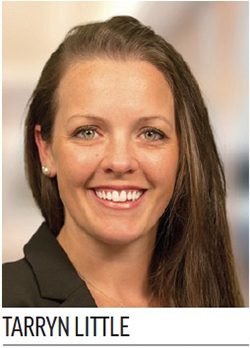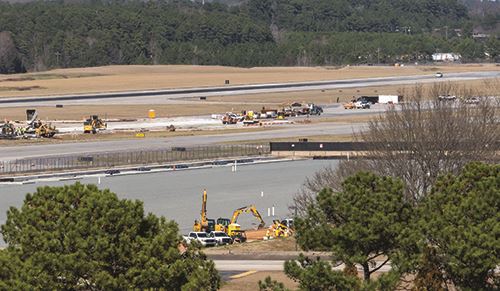This April, Raleigh-Durham International Airport (RDU) solved what many in the industry would consider a champagne problem with a new $33 million overnight parking ramp for aircraft.
“Champagne problems” may sound nice, but they still require time and money to fix.
 This April, Raleigh-Durham International Airport (RDU) solved what many in the industry would consider a champagne problem with a new $33 million overnight parking ramp for aircraft. Years of dramatic traffic growth had left the North Carolina airport with a shortage of such space, so RDU leaders included a new ramp in their Vision 2040 master planning process.
This April, Raleigh-Durham International Airport (RDU) solved what many in the industry would consider a champagne problem with a new $33 million overnight parking ramp for aircraft. Years of dramatic traffic growth had left the North Carolina airport with a shortage of such space, so RDU leaders included a new ramp in their Vision 2040 master planning process.
“We found ourselves in a situation where we were just literally running out of space to park large airplanes,” explains RDU Executive Vice President and Chief Development Officer Bill Sandifer. “As we continued to see significant growth, we started to formulate this project.”
|
facts&figures Project: Overnight Aircraft Parking Ramp Airport: Raleigh-Durham (NC) Int’l Airport Location: Near Terminal 2 Size: 585,000 sq. ft. Cost: $33 million Funding: NC Airport Improvement Program Design: 2017 Construction: Work began Jan. 2019, stopped in March 2020 due to COVID pandemic, resumed Aug. 2021 & ended April 2023 Opening Date: April 17, 2023 Project Manager/Design Engineer: RS&H Construction Manager at Risk: Balfour Beatty Paving Contractor: Summers Concrete Contracting Key Benefits: Providing needed overnight parking capacity; facilitating morning departures by staging airliners close to terminals; freeing space for future terminal expansion |
What began on the drawing board in 2017 is now a 585,000-square-foot holding area near Terminal 2 with room for eight large aircraft such as Boeing 737s and Boeing 777s. The new west parking area allows commercial airliners that arrive late at night to park close to Terminal 2, where a large percentage will load for takeoff the following morning. The area is also adjacent to hangars used by the North Carolina Department of Transportation and University of North Carolina.
“The pavement that was there wouldn’t support the weight of very large airplanes, so we had to do a complete reconstruction of the entire area,” Sandifer says.
Repurposing Pavement
Project manager RS&H ushered the initiative from the design phase that began in 2017 through construction that ended this spring. In the end, RDU had a new heavy-duty parking ramp in an area that used to accommodate general aviation aircraft and a modest cargo operation.
“The site was a lightweight apron that was falling apart,” explains RS&H Aviation Engineer Tarryn Little. “It was pretty aged, so we designed a 65,000-square-yard apron to encompass the existing footprint and to expand almost all the way back to International Drive.”
Construction began in 2019 but was temporarily halted when COVID-19 hit the area in March 2020. “We had done site grading and drainage, and we were getting ready to do some paving when we put it on the shelf,” recalls Sandifer.
Like the rest of the industry, RDU leaders took time to determine how the pandemic was going to affect business, and work on the project resumed in August 2021.
“As we slowly started to bring major capital programs back, we brought this project back,” Sandifer explains. “We didn’t cancel the contracts, but we put everything on hold. Interestingly enough, we picked it right back up where we started and finished it.”
After construction resumed, the project took about 20 months to complete.
 “It is not easy to walk away from a construction project,” Little reflects. “When you stop, there are a lot of things you have to do to ensure that the site doesn’t have any erosion control or drainage issues in the interim.”
“It is not easy to walk away from a construction project,” Little reflects. “When you stop, there are a lot of things you have to do to ensure that the site doesn’t have any erosion control or drainage issues in the interim.”
There were also logistic details to consider when the project resumed.
“When you restart, it is not a matter of continuing paving, it is taking out all of the temporary measures, and then there is rework associated when a project sits for a certain amount of time,” Little explains.
For instance, crews replaced stabilized base material that had cracked or was damaged from exposure to the elements for more than a year. They also brought in new underdrain stone and completed other preparatory work.
A cement shortage presented yet another challenge.
“ASTM C150 Type I and II cement is just not available anymore, so the industry as a whole has to move away from that,” says Little, adding that Summers Concrete successfully managed the transition to hydraulic cement for the parking apron.
The use of blended cements is becoming more common because they have smaller carbon footprints than Portland cements.

Built-In Flexibility
In retrospect, Little says that necessary changes (such as switching to a different type of cement) were more palatable for RDU because it used the construction manager at-risk contract delivery method for this project. The advantages were especially pronounced when restarting construction, she adds.
Horizontal work at airports has historically been contracted as design-bid-build projects, but RDU opted to include the West Remain Overnight Apron Project in a bundle of projects it solicited construction manager-at-risk firms for. Selection was based on qualifications, and Balfour Beatty was named the construction manager-at-risk for the apron project before the subsequent bid process began.
As the contract manager, Balfour Beatty solicited bids and gave RDU a guaranteed maximum price that included contingency items.
“If there were design or oversight changes that had to happen in the field or contractor changes, a lot of that was already included inside that allowance,” Little explains.
Sandifer is notably pleased with how the delivery method worked for RDU. “I have been doing projects at airports going on 37 years, and the construction manager-at-risk method of contracting has worked very effectively for us, not only on the airfield, but in other locations,” he remarks. “You get the benefit of selecting a construction manager based on qualifications and experience with the project. Once you hire the construction manager, all the work gets bid with first-tier subcontractors, so you get the benefit of a collaborative working relationship between the designer, the construction manager and the owner.
“Then there is the benefit of competitive pricing in terms of bidding for the different disciplines of work,” he adds. “So it really is an excellent delivery method for us, and we have had great success.”
Current and Future Benefits
With the new west overnight parking ramp in place, RDU has been able to relocate aircraft parking areas from other parts of the airport to allow for the future expansion of the terminal building.
“We are working through projects right now to expand Terminal 2 as well as Terminal 1 to accommodate the growth, so [this project] was a welcome addition to give us the flexibility to do that,” Sandifer says.

Clearly, the additional parking ramp was needed, because the area has been at 100% capacity ever since it opened on April 17.
“From day one, it has been full every single night,” Sandifer reports, noting that the new area stages airliners near the terminals at peak early morning times when planes are typically lined up waiting for a gate. “We are so very, very happy with the finished product.”



